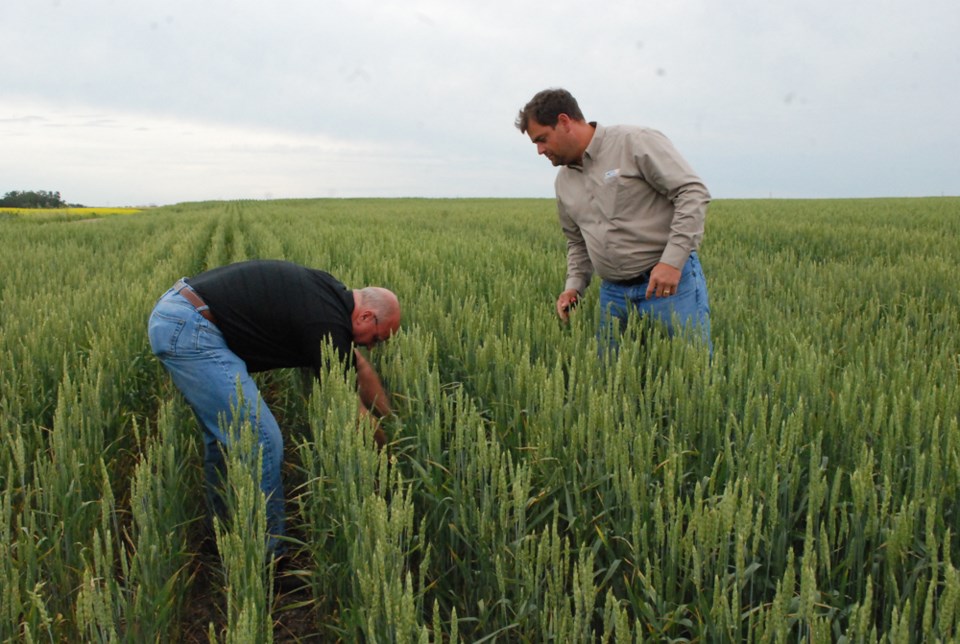Unlike the previous seasons where flooding was an issue, this year’s crop season was opened with drought and continued with intermittent rain showers. Growth of crops has been varied around the province.
On July 23, the 2015 CWB (Canadian Wheat Board) Crop Tour stopped in Humboldt to talk a bit about what they’ve seen so far. Every year, market research teams from the CWB go out on a tour across Canada to take a look at the crops and get estimates for the season’s anticipated crop output.
Chris Birk, one of the consultants on the tour, said the purpose of the tour is to check crop staging and different yields, take head and frame counts and just come up with estimates for wheat yields and report back.
For a while, many of the farms in Saskatchewan were suffering from a drought at the beginning of summer. Not a day too soon, they finally saw some rain, but even that was patchy in the province.
“We’ve seen a lot of things. There’s a lot of variability in all the crops. We’ve seen some drought, seen a lot of dryness and excess moisture,” said Birk. “That must have happened right after seeding that killed some of the plants off and then it got dry. We’ve seen some hail. One of the big things we can say is seasonal crop is so variable. You look at one side of the highway and it’s just starting to bloom and you look at the other side of the highway and is completely done blooming.”
Patti Durand, an agronomist currently working with Scotiabank as a small business consultant, invited the tour to Humboldt for lunch. She also invited her farming clients so that they can do some networking and compare notes on crop conditions.
Durand was interested to see how different conditions could be even just across the Prairies, but the information she was hearing did seem to be optimistic.
“It was probably more positive than I might have expected, but I know there are those that aren’t in as good shape,” she said. “I shouldn’t be surprised maybe. (Because of) the nature of this business, (it’s full of) optimists, but they’re realists too who know that it won’t be a homerun every year. But things are looking fairly good considering the recent moisture and the difference that made for crop development.”
Due to the excess of moisture in some areas and lack thereof in others, Birk said some areas are below average while others are above, which means they expect for crop production to be in the middle overall. There seem to be good crops in southeast Saskatchewan and they’ve been seeing some heavy crops. After it rained, he said it would be better for farmers to “go fishing” for a couple days before going out and checking their crops because by then they should have worked their way back up.
“It’s not at the point where it’s that flat that it’s going to cause damage, but it’s a good sign that there are some heavy wheat crops out there,” he said. “They’re not completely flat, but you kind of want to see those crops where it’s a little bit twisted and on the verge where at any given time they can go down. You just don’t want to hope for a lot of wind or rain to knock it down because that can cause some major problems for the crop not to finish properly.”
When the team does its assessment, they try to find the average spots in the field that are neither too good nor too bad so that they don’t skew the results. They have a one-foot frame that they stick in the row for their estimates. They count the number of heads in the frame and then the number of seeds in the plant itself. They do that three times in different places in the rows so as to get a good representative number of the crop yields for that field.
“So when we’re assessing crops, basically the only ones we’re doing counts on are the wheat crops, but it’s hard in some cases because in southern Manitoba they grow some intermediary crops where they’re in a different class,” he said. “So those might bump up the averages a little bit.”
Fortunately, Birk says they haven’t been seeing much fusarium; most of the fields they had seen up until that point were “pretty clean.” Since the crops have already finished flowering, he said there’s very little chance that the wheat crops will get disease now. Even southern Manitoba, which usually gets a lot more, didn’t get much disease this year.
For the farmers that attended, the luncheon was a chance to make more connections and find out what’s going on beyond the Humboldt area.
“When you look at what everyone’s trying to do in a lot of cases, I find that it doesn’t increase the price of the food yields or the return that we saw, it actually lowers it because people say you have so much more knowledge of what’s going on,” said Wayne Nahorniak, a farmer from Quill Lake whoattended the luncheon. “But on the positive side, it does create some open markets and marketing is becoming a main asset to this industry today.”




